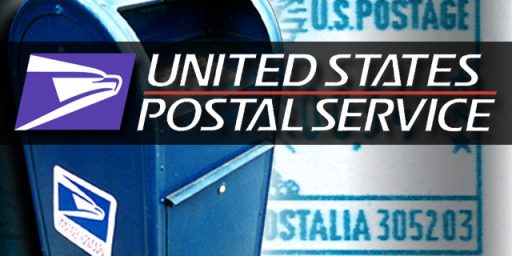Postal Service Killing Small Publications?
Josh Marshall prints an email from David Korn charging that,
Postal regulators have accepted a scheme designed in part by lobbyists for the Time-Warner media conglomerate. In short, mailing costs for mega-magazines like Time-Warner’s own Time, People and Sports Illustrated will go up less than other magazines or even decrease. But smaller publications like The Nation will be hit by an enormous rate increase of half a million dollars a year.
This struck me as quite bizarre, indeed, but a quick Google search revealed that the story has been developing for months. It seems that what’s really happening is a leveling of rates. Previously, the less popular magazines were being heavily subsidized.
The Boston Globe editors, writing in April, argued that this practice should be preserved:
The Postal Service’s mission, set by federal law, is to “bind the nation together through the personal, educational, literary, and business correspondence of the people.” It has a history of protecting the spread of information. So whether grandma lives down the street or in another time zone, a stamp for her birthday card costs the same.
Price protection has also been crucial for small magazines, helping them to add politically and socially diverse voices to the public arena. “In short, the post office and press together constituted the most important mechanism for the dissemination of public information at least until the Civil War,” Richard B. Kielbowicz writes in his book “News in the Mail: The Press, Post Office, and Public Information, 1700-1860s.”
Now, of course, there’s the Internet, which makes publishing seem easy and cheap. But as The Nation’s president, Teresa Stack, says, mailing out copies to paying subscribers is still largely how small magazines make money. Web content is often an extra that doesn’t generate income. Without income these publications can’t survive, and the public loses out when those voices are silenced.
Robert W. McChesney agrees.
In 1792, the United States Congress converted the free press clause in the First Amendment from an abstract principle into a living reality for Americans by providing newspapers with low postal rates. These low rates were crucial for the growth and spread of the abolitionist movement, the populist movement and progressive politics. More broadly, they have been central to development of participatory democracy in general.
[…]
Because the Postal Service is a monopoly, and because magazines must use it as their main distribution network, the postal rates have always been skewed to make it cheaper for smaller publications to launch and to survive.
The genius of the postal rate structure over the past 215 years was that it did not favor a particular viewpoint; it simply made it easier for smaller magazines. That is why the publications opposing the new postal rate hikes cross the political spectrum, and include the National Review, American Spectator, The Nation, Mother Jones and In These Times. This is a democracy issue. It is about fostering competitive media markets that benefit all Americans.
Time-Warner chairman Jim O’Brien begs to differ.
Time Warner supports cost-based rates. This means that if it costs the Postal Service $1.00 to deliver a product, it should charge $1.00 plus a reasonable contribution to overhead. Unfortunately, too many departures from this principle developed over the years and need to be corrected. For example, there are some mail sacks that cost the Postal Service $3.42 to process yet the total revenue paid by the mailer can be $1.50 (or less). The net result is that the Postal Service loses $1.92 on every one of these sacks that it processes. That’s bad business. To correct this problem, we’ve proposed that the Postal Service adopt a more cost-based rate structure so that mailers receive the proper price signals and begin to make their mail more efficient. There is no strategy to drive competitors out of business. The strategy is exactly the opposite. We want our competitors to eliminate inefficient practices and help drive costs from the system. The net result will be a healthy Postal Service that benefits all customers.
Both sides, of course, are arguing for a position that suits their interests. The big boys feel, reasonably enough, that their competitors shouldn’t be subsidized, especially on their backs. The niche publications feel they’re offering a valuable public service and argue they must be given special treatment to survive.
The Postal Service is a regulated monopoly that has to adopt some business practices that make no sense from a market perspective in order to serve the public good. We’ve decided that people living in rural areas and other relatively hard to reach locales should be subsidized at the expense of those who live in cities and other major population centers.
It’s less clear, though, why the relative handful of mostly affluent people who read niche opinion magazines need to be subsidized. National Review, The New Republic, and others have provided a valuable contribution to our political discourse over the years, serving as laboratories for ideas that filtered out to opinion leaders. With the proliferation of media outlets in recent years, though, their absence would hardly be noticed.






It’s hard to know where to start in discussing the “oughta be’s” of the USPS. Who should subsidize what and why?
My info may be dated but I seem to recall that First Class mail subsidizes Third Class or, said another way, the letters that you send are subsidizing the catalogs that fill your mail box most of which you’re not particularly interested in.
Should poor people in urban areas be subsidizing prosperous people in rural areas?
Once somebody has become accustomed to rent-seeking I guess we shouldn’t be surprised that they feel injured when the days at the trough come to a close but mightn’t a good place to start in reforming the USPS rate structure be dumping the USPS’s monopoly?
That’s my natural inclination as well. My understanding — and it’s admittedly quite cursory and perhaps outdated as well — is that regular mail service is essentially a loss leader. The USPS lost its monopoly on parcels years back and is now forced to deliver birthday cards to remote outposts in Alaska and Montana which it would decidedly prefer not to do. My guess is that UPS and FedEx wouldn’t rush to fill that void, either. So it may well be a necessary subsidy, unless we don’t want people to live in remote areas.
The question is to whom should the subsidy be paid? If mail subsidies are to be doled out, I’d rather see that they were distributed to individuals rather than companies and on the basis of need rather than wholesale.
I remember when The Nation took perverse pride in never making a profit.
I’m pretty sure they still don’t. But they still need to make money in order to pay salaries and whatnot.
As someone that is fairly aware of USPS mail-movement processes, the trade-off between the pitfalls of giving a company (which they basically are as they have not been subsidized by the US government since 1982) a monopoly on a class of mail versus requiring that class of mail to be able to reach all people within the country at a set rate is interesting. I can certainly attest that the movement of mail to Hawaii and Alaska (both of which have to be handled by plane even for the cheaper classes of mail for the obvious reason for Hawaii and for the fact that there just aren’t dependable roads connecting many parts of Alaska to each other), as well as to the rural parts of the continental US are not even in the ballpark of profitable. Don’t forget the overseas military mail and mail to US territories. More mail that doesn’t get close to being profitable. Of course, this is offset by the fact that this mail is relatively a drop in the bucket compared to larger volume areas such as cities and suburbs.